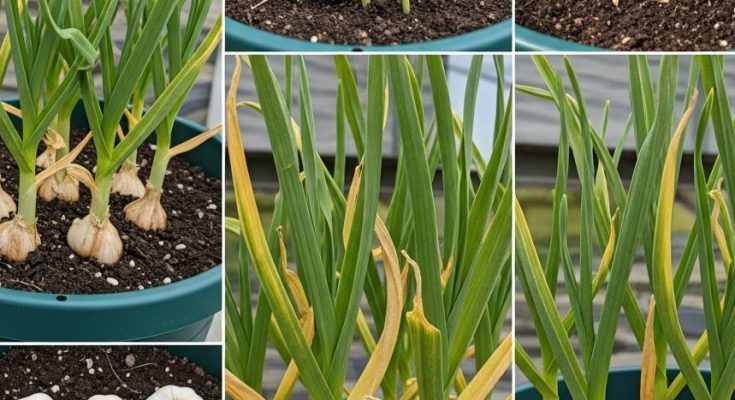Why Grow Garlic in Buckets?
Container gardening for garlic offers several advantages:
-
-
Space-saving – Buckets are ideal for small patios, balconies, or compact garden areas where traditional planting beds are unavailable.
-
Soil control – Growing garlic in a bucket allows you to provide fertile, well-draining soil tailored to garlic’s needs
-
-
Mobility – Buckets can be moved to follow sunlight or protect plants from heavy rain or extreme temperatures.
-
Pest and disease management – Container growth reduces exposure to soil-borne pests and diseases common in garden beds.
By choosing bucket gardening, even urban gardeners can grow high-quality garlic bulbs in limited space.
Step 1: Selecting the Right Bucket
The container you choose is essential for successful garlic cultivation:
-
-
Size – A 5-gallon (19-liter) bucket or larger works best. Garlic develops underground bulbs, and sufficient depth allows roots to grow freely.
-
Drainage – Drill multiple holes in the bottom to prevent waterlogging, which can lead to root rot.
-
Material – Plastic, clay, or metal buckets are suitable as long as they are sturdy enough to hold soil and moisture over time.
-
Proper container selection supports strong root systems and healthy garlic bulbs.
Step 2: Preparing the Soil
Garlic thrives in fertile, loose, and well-draining soil:
-
-
Soil mix – Combine garden soil, compost, and perlite or coarse sand in equal parts. This mixture retains moisture while ensuring proper drainage.
-
Soil pH – Garlic prefers slightly acidic to neutral soil, with a pH between 6.0 and 7.0.
-
-
Fertilization – Incorporate a balanced, slow-release fertilizer into the soil before planting to support root development and bulb formation.
A nutrient-rich soil mix is the foundation for strong, flavorful garlic bulbs.
Step 3: Preparing Garlic Cloves
Planting healthy garlic cloves is key to a successful crop:
-
-
Clove selection – Choose large, firm cloves from disease-free bulbs. Avoid small or damaged cloves.
-
-
Clove preparation – Separate individual cloves from the bulb, keeping the papery skin intact.
-
Planting orientation – Place each clove point-side up, with the flat root-side down, to encourage upward growth.
Healthy cloves result in larger, more vigorous bulbs at harvest.
Step 4: Planting Garlic
Proper planting depth and spacing ensure optimal growth:
-
-
Depth – Plant cloves about 2 inches (5 cm) deep into the soil.
-
Spacing – Leave 4–6 inches (10–15 cm) between cloves to allow room for bulb development.
-
Succession planting – If you want a staggered harvest, plant additional cloves every few weeks.
-
Correct planting techniques prevent overcrowding and promote robust bulb formation.
Step 5: Watering
Consistent moisture is essential for garlic growth:
-
-
Initial watering – Water thoroughly after planting to settle soil around the cloves.
-
Ongoing watering – Keep the soil evenly moist but avoid overwatering. Garlic has shallow roots that can dry out quickly but is also prone to rot if waterlogged.
-
-
Watering technique – Water at the soil level to prevent wet foliage, which can encourage fungal diseases.
Proper watering supports strong root and bulb development.
Step 6: Sunlight and Placement
Garlic requires full sun for optimal growth:
-
-
Light requirements – Place the bucket in a location receiving at least 6 hours of direct sunlight daily.
-
-
Temperature – Garlic prefers cooler temperatures for root establishment and warmer weather for bulb maturation. Move the bucket to a shaded spot if temperatures become extreme.
Adequate sunlight ensures vigorous growth and robust bulbs.
Step 7: Maintenance
Regular care is essential for a healthy garlic crop:
-
-
Fertilization – Apply liquid fertilizer every 3–4 weeks during the growing season to support leaf and bulb development.
-
-
Mulching – Add organic mulch to retain moisture, regulate temperature, and suppress weeds.
-
Pest monitoring – Inspect plants for aphids, mites, or fungal issues. Treat promptly to prevent damage.
Consistent maintenance improves yield and bulb quality.
Step 8: Harvesting Garlic
Harvesting at the right time ensures flavorful, firm bulbs:
-
-
Timing – Garlic is typically ready to harvest when the lower leaves start to yellow and dry, usually 8–10 months after planting.
-
Technique – Carefully loosen the soil around bulbs with a trowel and gently lift them to avoid damage.
-
Curing – Allow harvested bulbs to dry in a well-ventilated, shaded area for 2–3 weeks before storage.
-
Proper harvesting and curing maximize flavor and shelf life.
Final Thoughts
Bucket gardening is an excellent way to grow garlic in limited space. By selecting the right container, preparing fertile soil, planting healthy cloves, maintaining consistent water and sunlight, and monitoring care, gardeners can enjoy robust, flavorful garlic bulbs from their own home.
Even on a small balcony or patio, bucket-grown garlic provides a continuous source of fresh, aromatic bulbs, making it a practical and rewarding addition to home gardening.
